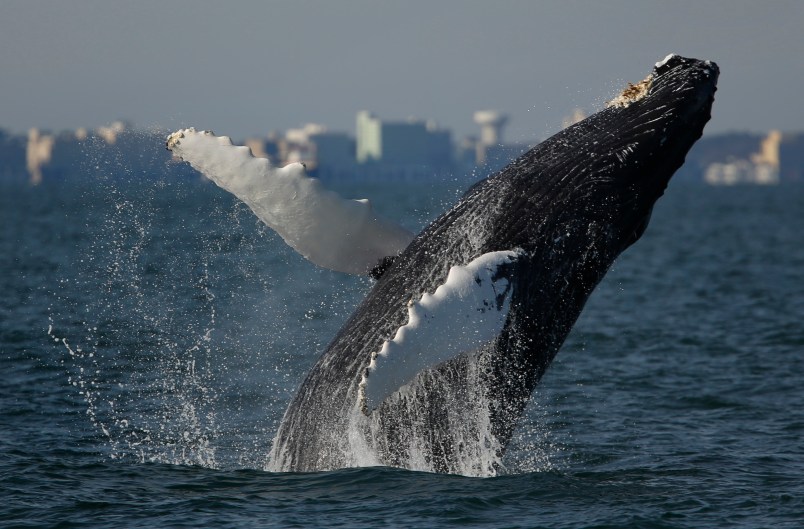PORTLAND, Maine (AP) — Government scientists launched an investigation Thursday into an unusually large number of humpback whale deaths from North Carolina to Maine, the first such “unusual mortality event” declaration in a decade.
Forty-one whales have died in the region in 2016 and so far in 2017, far exceeding the average of about 14 per year, said Deborah Fauquier, a veterinary medical officer with National Oceanic and Atmospheric Administration Marine Fisheries.
Ten of the 20 whales that have been examined so far were killed by collisions with boats, something scientists are currently at a loss to explain because there’s been no corresponding spike in ship traffic.
The investigation will focus on possible common threads like toxins and illness, prey movement that could bring whales into shipping lanes, or other factors, officials said.
Humpbacks can grow to 60 feet long and are found in oceans around the world. They’re popular with whale watchers because of the dramatic way they breach the ocean’s surface, then flop back into the water.
“The humpback is generally people’s favorite because they’re so animated. They’re the ones that like to jump out of the ocean completely,” said Zack Klyver, a naturalist with Bar Harbor Whale Watch Company.
The humpback whale population that feeds in North Atlantic waters each summer was removed from the Endangered Species Act last year when NOAA divided humpback populations into 14 distinct population segments around the world. There are currently about 10,500 in the population that visits North Atlantic waters, scientists say.
While they’re not threatened, federal scientists are nonetheless keeping close tabs on the whales, said NOAA spokeswoman Kate Brogan.
The humpback whale deaths that prompted the “unusual mortality event” designation break down to 26 last year and 15 to date this year.
NOAA also declared “unusual mortality events” involving humpbacks in 2003, 2005 and 2006, Fauquier said. No conclusive cause of the deaths was determined in those investigations, she said.
The 10 confirmed fatal boat strikes far exceeds the annual average of fewer than two per year attributed to boat collisions, officials said.
Whales tend to be somewhat oblivious to boats when they’re feeding or socializing, said Gregory Silber, coordinator of recovery activities for large whales in NOAA’s Office of Protected Resources.
“A vessel of any size can harm a whale. In smaller vessels they tend to be propeller strikes. And in larger vessels they appear to be in the form of blunt trauma, hemorrhaging or broken bones,” he said.
Klyver said any whale death is upsetting. Scientists and whale watchers know many of the whales that visit each summer.
“Each whale has its own personality,” he said. “We are connected to so many of them as individuals that we hate to see any of them perish.”
___
This story has been corrected to attribute a comment about past mortality events to Deborah Fauquier, a veterinary medical officer with NOAA, instead of Mendy Garron, NOAA’s regional stranding coordinator.
Copyright 2017 The Associated Press. All rights reserved. This material may not be published, broadcast, rewritten or redistributed.







Trying to understand cetacean mortality is a tricky thing. They may never know if there is a common factor in these deaths or not. One note, I’ve been working with marine mammals in Hawaii for over a decade and this year has seen a drop in stranding deaths along with a drop in entanglements. So quite a difference from one ocean to another.
Another note, I’ve seen thousands of humpback whales and I’ve never seen one 60 feet long. 50 is generally considered the maximum.